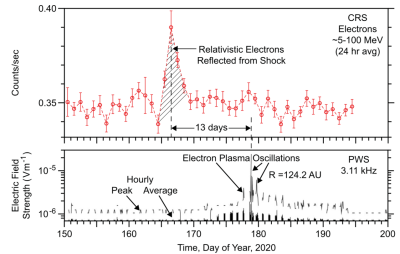Solar effects in the local interstellar medium
| Nugget | |
|---|---|
| Number: | 397 |
| 1st Author: | Don Gurnett |
| 2nd Author: | Hugh Hudson |
| Published: | 14 December 2020 |
| Next Nugget: | Solar X-ray polarization |
| Previous Nugget: | Investigation of Small-Scale Energy Releases in Hard X-rays with FOXSI |
Introduction
The Voyager spacecraft famously have extended humankind's direct experience way out into the local interstellar medium (LISM), and Ref. [1] now describes sudden bursts of relativistic particles that appear, a few times per solar cycle, out of this seemingly empty void. These particles have a close relationship with waves near the plasma frequency detected at a later time by the same spacecraft.
In a sense we are now now "touching" the LISM and the Sun itself at the same time, with the solar touches being via the Parker Solar Probe PSP in the inner heliosphere. The LISM, it should be understood, is a very peculiar plasma. The cosmic rays have an energy density comparable to that of the low-temperature gas itself - roughly 1 eV/cm3 for each. Far enough from a star, even the starlight itself has only a comparable energy density, although at the Voyager distances sunlight still matters.
Observations and explanations
One might not expect to see transient features in the interstellar medium, and so the observations of relativistic electrons depicted in Figure 1 must have been unexpected (but see Ref. [2]). This figure shows one of several similar events, observed on both Voyager 1 and Voyager 2. The latter spacecraft is now "deep" in interstellar space, about a decade after departure from the heliosphere, and hence it currently flies far beyond the heliopause and its associated termination shock.

The working hypothesis, as illustrated in the cartoon of Figure 2, is that flares and CMEs far back at the Sun, and long before the event, had driven ICME disturbances out into the heliopause, specifically a global shock front, that penetrated beyond it and into the pristine interstellar medium. One direct signature of the shock is electron plasma oscillations (Langmuir waves) at very low frequencies, because of the very low densities (below 0.1 particles/cm3) that far out into the void.

These effects result from solar eruptions that only generate energy and momentum on time scales of minutes to tens of minutes, but in the interstellar medium the effects are weak, very extended and long-lived. They thus require long data integrations (Figure 1 shows 24-hour averages of data in a time sequence of 50 days). The detected interstellar effects appear many months after the flare/CME had happened, and in fact may reflect multiple events merged together during their long trip outward.
Conclusions
The Voyager observations reported from beyond the heliopause show solar effects, which is remarkable; Voyager 1 had detected eight such events at the time of writing. In a sense this capability marks the dawn of in situ astronomy, but thus far the only detectable transients seen from an interstellar perspective turn out to be from the Sun itself. Future exploratory missions may see much more! These observations have added yet another messenger to modern multimessenger astronomy.
References
[1] "A Foreshock Model for Interstellar Shocks of Solar Origin: Voyager 1 and 2 Observations"